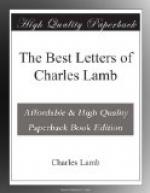John Lamb had married Elizabeth Field, whose mother was for fifty years housekeeper at the country-seat of the Plumers, Blakesware, in Hertfordshire, the “Blakesmoor” of the Essays, frequent scene of Lamb’s childish holiday sports,—a spacious mansion, with its park and terraces and “firry wilderness, the haunt of the squirrel and day-long murmuring wood-pigeon;” an Eden it must have seemed to the London-bred child, in whose fancy the dusty trees and sparrows and smoke-grimed fountain of Temple Court had been a pastoral. Within the cincture of its excluding garden-walls, wrote Elia in later years, “I could have exclaimed with that garden-loving poet, [2]—
“’Bind me, ye woodbines, in
your twines;
Curl me about, ye gadding vines;
And oh, so close your circles lace
That I may never leave this place:
But lest your fetters prove too weak,
Ere I your silken bondage break,
Do you, O brambles, chain me too,
And, courteous briers, nail me through.’”
At Blakesware, too, was the room whence the spirit of Sarah Battle—that “gentlewoman born”—winged its flight to a region where revokes and “luke-warm gamesters” are unknown.
To John and Elizabeth Lamb were born seven children, only three of whom, John, Mary, and Charles, survived their infancy. Of the survivors, Charles was the youngest, John being twelve and Mary ten years his senior,—a fact to be weighed in estimating the heroism of Lamb’s later life. At the age of seven, Charles Lamb, “son of John Lamb, scrivener, and Elizabeth, his wife,” was entered at the school of Christ’s Hospital,—“the antique foundation of that godly and royal child King Edward VI.” Of his life at this institution he has left us abundant and charming memorials in the Essays, “Recollections of Christ’s Hospital,” and “Christ’s Hospital Five-and-thirty Years Ago,”—the latter sketch corrective of the rather optimistic impressions of the former.
With his schoolfellows Charles seems to have been, despite his timid and retiring disposition (he said of himself, “while the others were all fire and play, he stole along with all the self-concentration of a young monk"), a decided favorite. “Lamb,” wrote C. V. Le Grice, a schoolmate often mentioned in essay and letter, “was an amiable, gentle boy, very sensible and keenly observing, indulged by his schoolfellows and by his master on account of his infirmity of speech.... I never heard his name mentioned without the addition of Charles, although, as there was no other boy of the name of Lamb, the addition was unnecessary; but there was an implied kindness in it, and it was a proof that his gentle manners excited that kindness.”
For us the most important fact of the Christ’s Hospital school-days is the commencement of Lamb’s life-long friendship with Samuel Taylor Coleridge, two years his senior, and the object of his fervent hero-worship. Most of us, perhaps, can find the true source of whatever of notable good or evil we have effected in life in the moulding influence of one of these early friendships or admirations. It is the boy’s hero, the one he loves and reverences among his schoolfellows,— not his taskmaster,—that is his true teacher, the setter of the broader standards by which he is to abide through life. Happy the man the feet of whose early idols have not been of clay.




